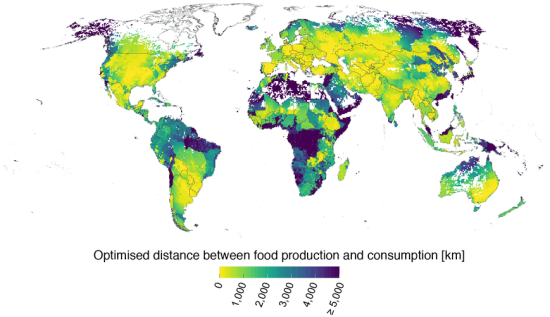A study by an international team of researchers led by Aalto University finds that less than one-third of the world’s population could currently meet their demand for food with food produced in their local vicinity. The paper is published in the journal Nature Food.
Globalization has revolutionized food production and consumption in recent decades and cultivation has become more efficient, and as a result, many people’s diets have diversified and food availability has increased in various parts of the globe. However, it has also led to a situation where the majority of the world population live in countries that are dependent on, at least partially, imported food. This can intensify vulnerabilities during any kind of global crisis, such as the current COVID-19 pandemic, as global food supply chains are disrupted.
There are big differences between different areas and the local foliage. For example, in Europe and North America, temperate crops, such as wheat, can be obtained mostly within a radius of 500 kilometers. In comparison, the global average is about 3,800 kilometers.
—Pekka Kinnunen, lead author
The study modeled the minimum distance between from crop production to consumption that humans around the world would need to be able to meet their food demand. The study was conducted in collaboration with the University of Columbia, the University of California, the Australian National University and the University of Göttningen.
The study factored in six key crop groups for humans: temperate cereals (wheat, barley, rye); rice; corn; tropical grains (millet, sorghum); tropical roots (cassava); and pulses. The researchers modeled globally the distances between production and the consumer for both normal production conditions and scenarios where production chains become more efficient due to reduced food waste and improved farming methods.
It was shown that 27% of the world’s population could get their temperate cereal grains within a radius of fewer than 100 kilometers. The share was 22% for tropical cereals, 28% for rice and 27% for pulses. In the case of maize and tropical roots, the proportion was only 11-16%, which Kinnunen says displays the difficulty of relying solely on local resources.
We defined foodsheds as areas within which food production could be self-sufficient. In addition to food production and demand, food fences describe the impact of transport infrastructure on where food could be obtained.
—Pekka Kinnunen
The study also showed that foodsheds are mostly relatively compact areas for individual crops. When crops are looked at as a whole, foodsheds formed larger areas, spanning the globe. This indicates that the diversity of our current diets creates global, complex dependencies.
According to Associate professor Matti Kummu, who was also involved in the study, the results clearly show that local production alone cannot meet the demand for food—at least not with current production methods and consumption habits.
Increasing the share of effectively managed domestic production would probably reduce both food waste and greenhouse gas emissions. However, at the same time, it could lead to new problems such as water pollution and water scarcity in very densely populated areas, as well as vulnerabilities during such occurrences as poor harvests or large-scale migration.
Although we deliberately focus on the physical constraints
affecting food transportation, future research might look at the constraints
limiting practical feasibility. This includes trade networks
and agreements, as well as the economic costs of food production,
consumption and logistics beyond distance and time. Within local
and global value chains, it is also important to capture intermediate
steps involving storage or processing, both in terms of transportation
to facilities and potential for degradation or losses during
storage, transport and processing. A more detailed representation
of transportation networks would enable us to look at the vulnerability
of trade routes and how that could impact the regional or global trade network, or even the magnitude of benefits gained
from improving infrastructure.—Kinnunen et al.
Resources
-
Pekka Kinnunen, Joseph H. A. Guillaume, Maija Taka, Paolo D’odorico, Stefan Siebert, Michael J. Puma, Mika Jalava, Matti Kummu (2020) “Local food crop production can fulfil the demand for less than one-third of the population”
Nature Food doi: 10.1038/s43016-020-0060-7
